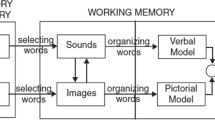Abstract
One of the challenges found with learning using a lecture video is the short attention span of students due to high cognitive load when they are watching the video. Several methods have been proposed to increase students’ attention, such as segmenting learning content into smaller pieces where each piece has short video duration. In this study we proposed an enhanced monologue lecture video with a tutee agent to mimic the dialogue between a tutor and a tutee to increase student attention to the lecture video. Based on lab evaluation including eye fixations data from an eye tracker, the videos enhanced with the tutee agent make the students’ attention more frequent to the learning material presented in the lecture video and at the same time lowering their attention span to it.
Access this chapter
Tax calculation will be finalised at checkout
Purchases are for personal use only
Similar content being viewed by others
References
Zhang, D., Zhou, L., Briggs, R.O., Nunamaker, J.F.: Instructional video in e-learning: assessing the impact of interactive video on learning effectiveness. Inf. Manag. 43, 15–27 (2006). https://doi.org/10.1016/j.im.2005.01.004
Brame, C.J.: Effective educational videos: principles and guidelines for maximizing student learning from video content. CBE Life Sci. Educ. (2016). https://doi.org/10.1187/cbe.16-03-0125
Jing, H.G., Szpunar, K.K., Schacter, D.L.: Interpolated testing influences focused attention and improves integration of information during a video-recorded lecture. J. Exp. Psychol. Appl. (2016). https://doi.org/10.1037/xap0000087
Mayer, R. (ed.): The Cambridge Handbook of Multimedia Learning. Cambridge University Press, Cambridge (2014)
Ilioudi, C., Giannakos, M.N., Chorianopoulos, K.: Investigating differences among the commonly used video lecture styles. In: CEUR Workshop Proceedings, vol. 983, pp. 21–26 (2013)
Chi, M.T.H., Kang, S., Yaghmourian, D.L.: Why students learn more from dialogue-than monologue-videos: analyses of peer interactions. J. Learn. Sci. 26, 10–50 (2017). https://doi.org/10.1080/10508406.2016.1204546
Cohen, P.A., Kulik, J.A., Kulik, C.C., Cohen, P.A.: Educational outcomes of tutoring: a meta-analysis of findings. Am. Educ. Res. Assoc. 19, 237–248 (1982)
Clark, R.E., Choi, S.: Five design principles for experiments on the effects of animated pedagogical agents. J. Educ. Comput. Res. 32, 209–225 (2005). https://doi.org/10.2190/7LRM-3BR2-44GW-9QQY
Hayashi, Y.: Influence of social communication skills on collaborative learning with a pedagogical agent: Investigation based on the autism-spectrum quotient. In: HAI 2015 - Proceedings of the 3rd International Conference on Human-Agent Interaction, pp. 135–138 (2015). https://doi.org/10.1145/2814940.2814946
Craig, S.D., Gholson, B., Ventura, M., Graesser, A.C.: Overhearing dialogues and monologues in virtual tutoring sessions: effects on questioning and vicarious learning. Int. J. Artif. Intell. Educ. 11, 242–253 (2000)
Park, S.W., Kim, C.: The effects of a virtual tutee system on academic reading engagement in a college classroom. Educ. Tech. Res. Dev. 64(2), 195–218 (2015). https://doi.org/10.1007/s11423-015-9416-3
Shaw, E., Johnson, W.L., Ganeshan, R.: Pedagogical agents on the Web. In: Proceedings of the International Conference on Autonomous Agents, pp. 283–290 (1999). https://doi.org/10.1145/301136.301210
Kassner, M., Patera, W., Bulling, A.: Pupil: an open source platform for pervasive eye tracking and mobile gaze-based interaction (2014). https://doi.org/10.1145/2638728.2641695
Liu, H., Heynderickx, I.: Visual attention in objective image quality assessment: based on eye-tracking data. IEEE Trans. Circuits Syst. Video Technol. 21, 971–982 (2011). https://doi.org/10.1109/TCSVT.2011.2133770
Blokzijl, W., Andeweg, B.: The effects of text slide format and presentational quality on learning in college lectures. In: IPCC 2005. Proceedings. International Professional Communication Conference, 2005, Limerick, Ireland, pp. 288–299. IEEE (2005)
Driscoll, D.M., Craig, S.D., Gholson, B., Ventura, M., Hu, X., Graesser, A.C.: Vicarious learning: effects of overhearing dialog and monologue-like discourse in a virtual tutoring session. J. Educ. Comput. Res. 29, 431–450 (2005). https://doi.org/10.2190/q8cm-fh7l-6hju-dt9w
ELAN (Version 5.9). Nijmegen: Max Planck Institute for Psycholinguistics, The Language Archive (2020)
Mayer, R.E., Dow, G.T., Mayer, S.: Multimedia learning in an interactive self-explaining environment: what works in the design of agent-based microworlds? J. Educ. Psychol. 95, 806–812 (2003)
Barrouillet, P., Bernardin, S., Portrat, S., Vergauwe, E., Camos, V.: Time and cognitive load in working memory. J. Exp. Psychol. Learn. Mem. Cogn. 33, 570–585 (2007). https://doi.org/10.1037/0278-7393.33.3.570
Biard, N., Cojean, S., Jamet, E.: Effects of segmentation and pacing on procedural learning by video. Comput. Hum. Behav. (2018). https://doi.org/10.1016/j.chb.2017.12.002
Author information
Authors and Affiliations
Corresponding author
Editor information
Editors and Affiliations
Rights and permissions
Copyright information
© 2020 Springer Nature Switzerland AG
About this paper
Cite this paper
Nugraha, A., Wahono, I.A., Zhanghe, J., Harada, T., Inoue, T. (2020). Creating Dialogue Between a Tutee Agent and a Tutor in a Lecture Video Improves Students’ Attention. In: Nolte, A., Alvarez, C., Hishiyama, R., Chounta, IA., Rodríguez-Triana, M., Inoue, T. (eds) Collaboration Technologies and Social Computing . CollabTech 2020. Lecture Notes in Computer Science(), vol 12324. Springer, Cham. https://doi.org/10.1007/978-3-030-58157-2_7
Download citation
DOI: https://doi.org/10.1007/978-3-030-58157-2_7
Published:
Publisher Name: Springer, Cham
Print ISBN: 978-3-030-58156-5
Online ISBN: 978-3-030-58157-2
eBook Packages: Computer ScienceComputer Science (R0)




